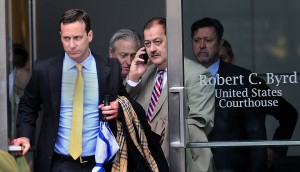4 things to know about the ‘Allen charge’ issued to the jury in the Don Blankenship trial
December 1, 2015 by Ken Ward Jr.
Today’s move by U.S. District Judge Irene Berger to deliver an “Allen charge” to jurors is a potentially significant development in the Don Blankenship trial.
Here’s what you need to know:
— The “Allen charge” is not a new concept: The name comes from an 1896 U.S. Supreme Court case called “Allen v. United States.”
The case involved 14-year-old Alexander Allen who was tried and convicted twice of killing 18-year-old Phillip Henson. During a third trial in which Allen was eventually convicted again, jurors told the trial judge they were deadlocked. The Judge Isaac Parker instructed the jurors to re-examine their opinions, thus leading to what has come to be known as an Allen charge. Parker’s instruction was nearly verbatim from Commonwealth v Tuey, which was an 1851 Massachusetts state court decision that used similar instructions.
In its ruling affirming Allen’s third conviction, the Supreme Court upheld the trial court’s instructions that jurors should carefully examine their views and consider whether they could be wrong:
The very object of the jury system is to secure unanimity by a comparison of views, and by arguments among the jurors themselves. It certainly cannot be the law that each juror should not listen to the arguments, and with a distrust of his own judgment, if he finds a large majority of the jury taking a different view of the case from what he does himself.
It cannot be that each juror should got to the jury room with a blind determination that the verdict shall represent his opinion or the case at that moment, or that he should close his ears to the arguments of men who are equally honest and intelligent as himself.
— It’s controversial: Especially when given in strong terms, Allen instructions are sometimes referred to as “dynamite” charges because of their ability to “blast” a verdict out of a deadlocked jury.
An Allen Charge has also been referred to as a “nitroglycerin charge,” “the third degree instruction” and a “shotgun instruction.”
On appeal, Allen charges can sometimes be overturned if they are determined to have had an “impermissibly coercive” effect on the jury. For example, judges are generally not supposed to tell juries that they “must” reach a verdict. Also, judges have been advised not to give an Allen charge after inquiring into the numerical division of the jury. In these cases, holdout jurors could interpret the charge as directed specifically at them.
Some defense lawyers argue — as Bill Taylor did on Blankenship’s behalf — that a defendant has a right to a hung jury. In a 1970 case called United States v. Sawyers, the 4th Circuit said that theory is wrong. A defendant, the court said, “has only the right to have the jury speak without being coerced.”
The 4th Circuit has said that one way for trial judges to avoid coercion when giving an Allen charge is to instruct both jurors in the minority and those in the majority to re-examine their positions, as Judge Berger did in the Blankenship case.
— It’s legal in this jurisdiction: Although several courts have disallowed the use of an Allen charge – for fear of it being coercive and possibly singling out minority jurors – this past March, the 4th U.S. Circuit Court of Appeals — which includes West Virginia — upheld the use of an Allen charge.
In fact, the 4th Circuit ruled in that case that a trial judge could deliver not just one — but two — Allen charges. The court declined to set a limit on the number of times judges can use the instruction to try to encourage continued deliberations. The 4th Circuit said it reviews appeals of Allen charges based on the “likelihood of coercion” of jurors. Some of the factors to be considered include the language of the instruction, its incorporation with other instructions, the timing of the instructions, and the length of the jury’s subsequent deliberations.
The 4th Circuit said, for example, that three hours of deliberations after a second Allen charge provided “adequate assurance” that the jury was not “improperly coerced.” Also, “very tellingly,” the court said, the jury in the case came back with a split verdict — further suggesting they had not been coerced.
At the government’s request, Judge Berger in the Blankenship case included in her Allen charge an instruction that jurors could return a verdict on some counts, but not on others. The 4th Circuit ruling this March also upheld an Allen charge that included language telling a deadlocked jury that a mistrial could result in lost “time, money and other resources” if the case had to be retried. Judge Berger declined to use such language in her Allen charge in the Blankenship case.
— Judges have broad discretion in these circumstances: Appeals courts have ruled that trial-court judges like Judge Berger are often “in the best position to gauge whether a jury is deadlocked or able to proceed further with its deliberations.
The U.S. Supreme Court has ruled that trial judges may declared a mistrial “whenever in their opinion, taking all the circumstances into consideration, there is a manifest necessity” for doing so. The decision is left to the “sound discretion” of the judge, but the power “ought to be used with the greatest of caution, under urgent circumstances, and for very plain and obvious causes.”

 Subscribe to the Coal Tattoo
Subscribe to the Coal Tattoo
